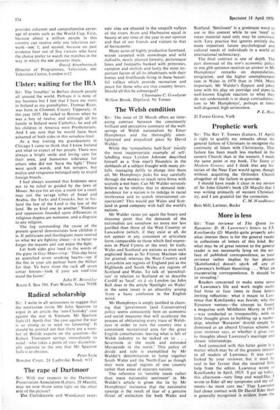More is less
Sir: Your reviewer of The Quest for Rananim: D. H. Lawrence's letters to SS. Koteliansky (21 March) quite properly asks what interest there is for the general reader in collections of letters of this kind. But what may be of great interest to the general reader is not necessarily lying on the sur- face of published correspondence, as your reviewer rather implies by her phrases '[Koteliansky] doesn't spark off any of Lawrence's brilliant theorising . . . What an exasperating correspondence. It should be sl revealing.'
Readers concerned to make some sense of Lawrence's life and work might easily find three or four items in these letters inviting reflection: what it meant to Law- rence that Koteliansky was Jewish; why the Signature venture—the attempt to found a magazine with Middleton Murry in 1915 —was conducted so irresponsibly, with so little thought given to building up a reader- ship; whether `Rananim' should simply be dismissed as an absurd Utopian scheme, as your reviewer says, or whether it gives rise to thoughts about Lawrence's marriage and closest relationships.
And connected with this latter point is a matter which may be of the greatest interest to all readers of Lawrence. It was over- looked by your reviewer, but it must be said in her favour that she received little help from the editor. Lawrence wrote to Koteliansky in April, 1915: 'I got up today. this afternoon—very limp and weed-like. .1 wrote to Eder all my symptoms and my ail- ments—he must cure me.' mat Lawrence had closer contact with Dr David Eder than is generally recognised is evident from the presence of uncollected Lawrence letters in a book unreferred to in biographies of Lawrence: David Eder: Memoirs of a Nfodern Pioneer edited by J. B. Hobman and with a foreword by Sigmund Freud (Gollancz, 1945). The point of quoting the letter is this: although Lawrence had phy- sical ailments, and was in bed with a -cold in the first week of April, it seems unlikely that in writing to Eder he would confine himself to those matters. Eder was a Freud- ian analyst, and that Lawrence wrote out 'all my symptoms and my ailments' for him —when all the evidence hitherto has sug- gested that Lawrence should be thought of solely as a critic of Freudianism—opens new possibilities for exploration. It may incidentally suggest that Lawrence may have been at an exceptionally low ebb at that time. And I notice that Eder translated Bresler's The Treatment of Syphilis in 1910, and as an authority on the subject may have put Lawrence onto the information which appears in the fine late essay 'Introduction to these Paintings'.







































 Previous page
Previous page